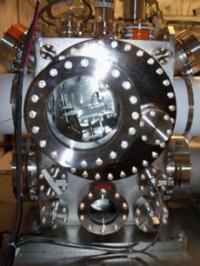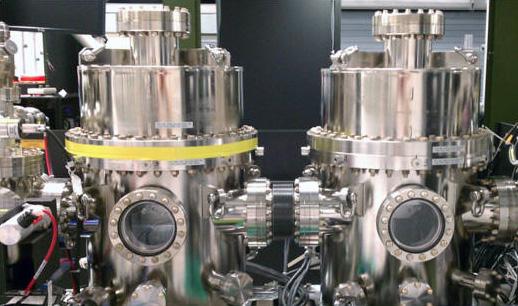XPP Components
A comprehensive overview of the XPP instrument is published in
Journal of Synchrotron Radiation, 22, (2015).
Channel Cut Monochromator

An artificial channel-cut monochromator (CCM) is available for use on the XPP instrument. The system design is adopted from the work of Narayanan et al. (J. Synchrotron Rad. (2008) 15, 12-18). This system currently uses Si (111) crystals and thus has a energy resolution of 1.4 x 10-4 (ΔE/E). The mechanics of this system are appropriate for scanning measurements such as those required for various X-ray spectroscopies. The CCM may be retracted when not needed. Please note that the CCM displaces the beam +7.5 mm in the vertical plane.
X-ray Focusing Lenses
The beam can be focused by inserting Beryllium compound refractive lenses in the beam path. The focal length can be adjusted for a given X-ray energy by selecting an appropriate number of individual lenses (up to 10) and stacking them. One can switch from one stack to another (up to three) remotely. Such a unit is located 4 meters upstream from the sample. The focusing unit has the capability to be translated longitudinally ±0.15 m. This allows some tunability in the beam size at the sample when not working at the focus.
Harmonic Rejection Mirrors

Local harmonic rejection is provided by two silicon mirrors located 1.9 and 2.4 m upstream the sample location. These also offer the possibility to provide the beam with a grazing angle to the sample. Both mirrors can rotate 360°, and can thus deflect the beam downwards of upwards depending on the required scattering geometry.
Laser in-coupling Box(LIB)
Diffractometer

A configurable diffractometer system is available at XPP. The system is capable of positioning a wide variety of sample environments with a platform setup. The top surface of the platform diffractometer is 400 x 400 mm2. The distance between the top surface of the diffractometer and its center or rotation is 230 mm nominal. The top stages of the platform may be replaced with a kappa diffractometer that may be more appropriate for positioning small samples over a wide angular range.
A robotic detector positioned is used to move various X-ray detectors to a desired location. This system has the capability of positioning the detectors over a spherical surface of radii ranging from 10-100 cm. The detector positioned may also be moved in a Cartesian coordinate system.
XPP Videos
A flyover view of the XPP instrument. For more XPP related videos, see the LCLS XPP playlist on YouTube.
Download animation (right click and save link as):

XPP | X-ray Pump Probe (XPP) Instrument
XPP CONTACTs
Takahiro Sato
XPP Instrument Lead
(650) 926-3749
[email protected]
Adam White
Area Manager
(650) 926-4778
[email protected]
Roberto Alonso-Mori
Spectroscopy Scientist
(650) 926-4179
[email protected]
Diling Zhu
Methologist/X-ray Optics Scientist
(650) 926-2913
[email protected]
Matthieu Chollet
Staff Scientist
(650) 926-3458
[email protected]
Sanghoon Song
Staff Scientist
(650) 926-2255
[email protected]
Yanwen Sun
XPCS/X-ray Optics Scientist
(650) 926-2562
[email protected]
Hasan Yavas
IXS /RIXS Scientist
(650) 926-3084
[email protected]
Matthias Hoffmann
Laser Scientist
(650) 926-4446
[email protected]
Ying Chen
Mechanical Engineer
[email protected]
Vincent Esposito
Controls & DAQ Engineer
(650) 926-3410
[email protected]
XPP Control Room
(650) 926-1703
XPP Hutch
(650) 926-7463


